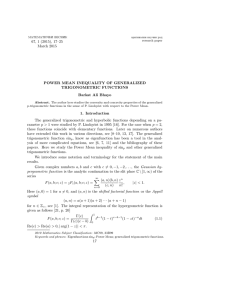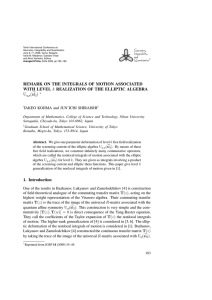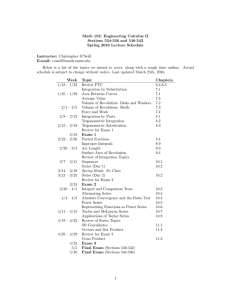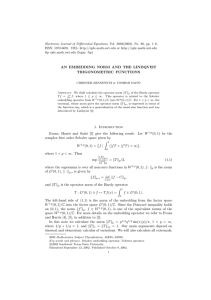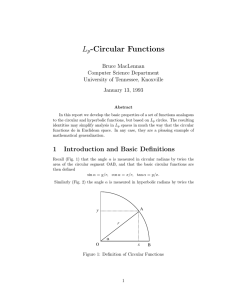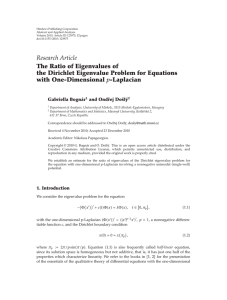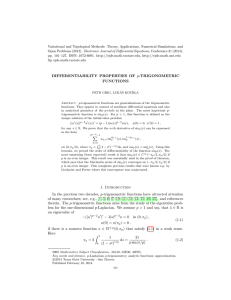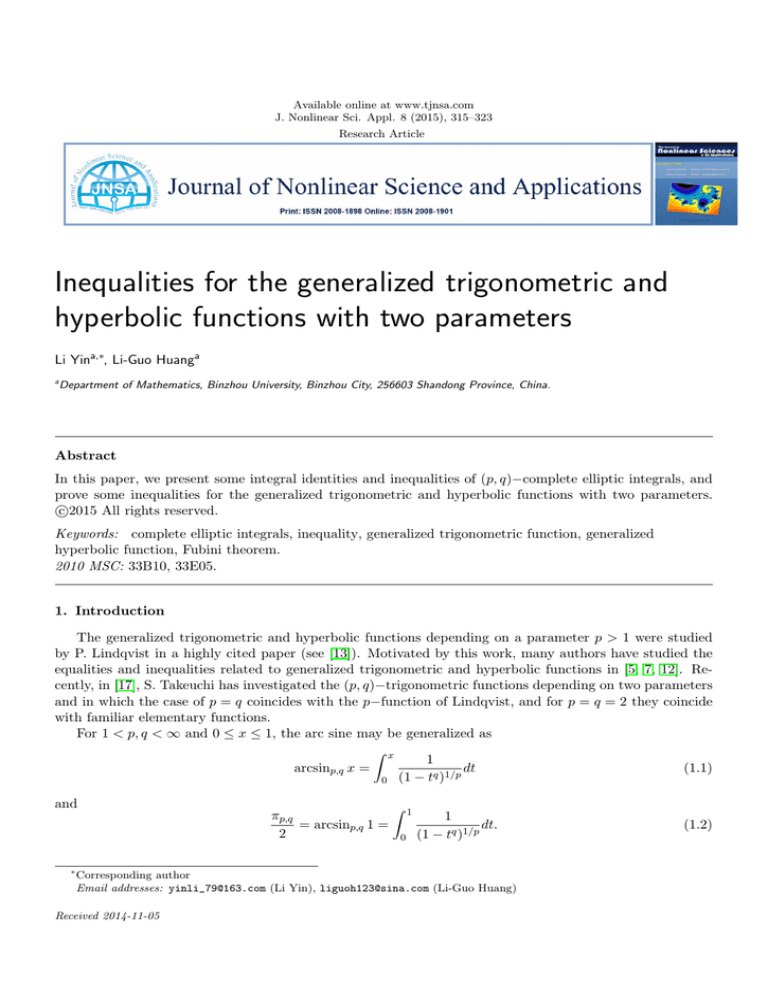
Available online at www.tjnsa.com
J. Nonlinear Sci. Appl. 8 (2015), 315–323
Research Article
Inequalities for the generalized trigonometric and
hyperbolic functions with two parameters
Li Yina,∗, Li-Guo Huanga
a
Department of Mathematics, Binzhou University, Binzhou City, 256603 Shandong Province, China.
Abstract
In this paper, we present some integral identities and inequalities of (p, q)−complete elliptic integrals, and
prove some inequalities for the generalized trigonometric and hyperbolic functions with two parameters.
c
2015
All rights reserved.
Keywords: complete elliptic integrals, inequality, generalized trigonometric function, generalized
hyperbolic function, Fubini theorem.
2010 MSC: 33B10, 33E05.
1. Introduction
The generalized trigonometric and hyperbolic functions depending on a parameter p > 1 were studied
by P. Lindqvist in a highly cited paper (see [13]). Motivated by this work, many authors have studied the
equalities and inequalities related to generalized trigonometric and hyperbolic functions in [5, 7, 12]. Recently, in [17], S. Takeuchi has investigated the (p, q)−trigonometric functions depending on two parameters
and in which the case of p = q coincides with the p−function of Lindqvist, and for p = q = 2 they coincide
with familiar elementary functions.
For 1 < p, q < ∞ and 0 ≤ x ≤ 1, the arc sine may be generalized as
Z x
1
arcsinp,q x =
dt
(1.1)
q 1/p
0 (1 − t )
and
πp,q
= arcsinp,q 1 =
2
∗
Z
0
1
1
dt.
(1 − tq )1/p
Corresponding author
Email addresses: yinli_79@163.com (Li Yin), liguoh123@sina.com (Li-Guo Huang)
Received 2014-11-05
(1.2)
L. Yin, L. G. Huang, J. Nonlinear Sci. Appl. 8 (2015), 315–323
316
π The inverse of arcsinp,q on 0, p,q
is called the generalized (p, q)−sine function, denoted by sinp,q , and
2
may be extended to (−∞, ∞). In the same way, we can define the generalized (p, q)−cosine function, the
generalized (p, q)−tangent function and their inverses. Their definitions and formulas can be found in [9, 11].
Similarly, we can define the inverse of the generalized (p, q)−hyperbolic sine function as follows.
Z x
1
dt
(1.3)
arcsinhp,q x =
q 1/p
0 (1 + t )
and also other corresponding (p, q)−hyperbolic functions. In [6], B. A. Bhayo and M. Vuorinen establish
some inequalities and present a few conjectures for the (p, q)−functions. Very recently, a conjecture posed
in [6] was verified in [11].
Legendre’s complete elliptic integrals of the first and second kind are defined for real numbers 0 < r < 1
by
Z π/2
Z 1
1
1
p
p
κ(r) =
dt =
dt
(1.4)
2
2
2
(1 − t )(1 − r2 t2 )
0
0
1 − r sin t
and
Z
π/2 p
1−
ε(r) =
Z
r2 sin2 tdt
1
r
=
0
0
1 − r2 t2
dt
1 − t2
(1.5)
respectively. The complete elliptic integrals have many applications in several mathematical branches as well
as in engineering and physics. Motivated by problems in potential theory and in the theory of quasi-conformal
mappings, many mathematicians obtain monotonicity and convexity theorems of certain combinations of
κ(r) and ε(r). See [1, 2, 3, 4, 8, 10, 15, 18].
In the second section of the paper, we define (p, q)− complete elliptic integrals, and prove some integral identities and inequalities. In the final section, we obtain some inequalities related to generalized
trigonometric and hyperbolic functions with two parameters.
2. Some properties related to (p, q)-complete elliptic integrals
Definition 2.1. For all p, q ∈ (1, ∞) and r ∈ (0, 1), the following the first and second kind of (p, q)-complete
elliptic integrals are defined by
(
R π /2
1
κp,q (r) = 0 p,q
1/p dθ
(1−rq sinqp,q θ)
(2.1)
π
κp,q (0) = p,q
,
κ
(1)
=
∞,
p,q
2
and
(
εp,q (r) =
εp,q (0) =
R πp,q /2
1 − rq sinqp,q θ
0
πp,q
2 , εp,q (1) = 1.
1/p
dθ
(2.2)
respectively.
Remark 2.2. For p = q = 2, they coincide with the first and second kind of complete elliptic integrals.
Lemma 2.3 ([9]). For all p, q ∈ (1, +∞) and all θ ∈ (0,
πp,q
2 ],
then
sinp,q θ
2
≤
≤ 1.
πp,q
θ
Theorem 2.4. For all p, q ∈ (1, ∞), r ∈ (0, 1) and θ ∈ (0,
Z
1
Z
κp,q (r)dr =
0
0
πp,q
2 ),
πp,q /2
(2.3)
we have
θ
dθ.
sinp,q θ
(2.4)
L. Yin, L. G. Huang, J. Nonlinear Sci. Appl. 8 (2015), 315–323
317
Proof. The substitution t = xr turns the identity
x
Z
0
1
dt
(1 − tq )1/p
Z
1
arcsinp,q x =
into
(2.5)
1
dr
(1 − rq xq )1/p
(2.6)
1
dr.
(1 − rq sinqp,q θ)1/p
(2.7)
arcsinp,q x = x
0
Setting θ = arcsinp,q x, we have
θ
=
sinp,q θ
Z
0
1
From (2.7), it follows that
Z
πp,q /2
θ
dθ
sinp,q θ
1
πp,q /2
0
Z
Z
=
0
Z
0
πp,q /2
=
0
Z
=
!
1
dr dθ
(1 − rq sinqp,q θ)1/p
!
Z 1
1
dθ dr
q
1/p
q
0 (1 − r sinp,q θ)
1
κp,q (r)dr
(2.8)
0
by using Fubini theorem.
Corollary 2.5. For all p, q ∈ (1, ∞), r ∈ (0, 1), we have
Z 1
2
πp,q
πp,q
≤
κp,q (r)dr ≤
.
2
4
0
(2.9)
Proof. Using Lemma 2.3 and Theorem 2.4, we easily obtain the inequality (2.9).
π
Theorem 2.6. For all p, q ∈ (1, ∞), r ∈ (0, 1) and θ ∈ (0, p,q
2 ), we have
Z 1
Z 1
q
p
+
κp0 ,q (r)dr,
εp,q (r)dr =
p+q p+q 0
0
where
1
p
+
1
p0
(2.10)
= 1.
Proof. By definite integration by part, we have
Z x
Z
Z
0
1/p
q x
q x
q 1/p
q 1/p
q −1/p
(1 − t ) dt = x (1 − x ) +
(1 − t )
dt −
(1 − tq ) dt.
p
p
0
0
0
(2.11)
So, we have
Z
x
q
1/p
(1 − t )
0
1/p
p
q
dt =
x (1 − xq ) +
p+q
p+q
Z
x
(1 − tq )
−1/p0
dt.
The substitution t = xr turns (2.12) into
Z 1
Z 1
−1/p0
qx
p
q 1/p
q q 1/p
x
(1 − r x ) dr =
x (1 − x ) +
(1 − rq xq )
dr.
p+q
p+q 0
0
Setting θ = arcsinp,q x, we have
Z 1
(1 − rq sinqp,q θ)1/p dr =
0
(2.12)
0
p
q
cosp,q θ +
p+q
p+q
Z
0
1
(1 −
rq
1
dr.
sinqp,q θ)1/p0
Similar to the proof of Theorem 2.4, we easily obtain (2.10) by using Fubini theorem.
(2.13)
(2.14)
L. Yin, L. G. Huang, J. Nonlinear Sci. Appl. 8 (2015), 315–323
318
Theorem 2.7. For all p, q ∈ (1, ∞), r ∈ (0, 1), we have
ε0p,q (r) =
where
1
p
+
1
p0
q
εp,q (r) − κp0 ,q (r)
pr
(2.15)
= 1.
Proof. For all p, q ∈ (1, ∞), r ∈ (0, 1), we have
ε0p,q (r)
Z
q πp,q /2
=−
(1 − rq sinqp,q θ)(1−p)/p rq−1 sinqp,q θdθ
p 0
Z πp,q /2
q
=
(1 − rq sinqp,q θ)(1−p)/p 1 − rq sinqp,q θ − 1 dθ
pr 0
q
=
εp,q (r) − κp0 ,q (r) .
pr
Lemma 2.8 ([14]). Let f (x), g(x) be integrable functions in [a, b], both increasing or both decreasing. Then
1
b−a
Z
a
b
1
f (x)g(x)dx ≥
b−a
Z
a
b
1
f (x)dx ·
b−a
Z
b
g(x)dx.
(2.16)
a
If one of the functions f (x) or g(x) is nonincreasing and the other nondecreasing, then the inequality in
(2.16) is reversed.
πp,q
2 ),
Lemma 2.9. For all p, q ∈ (1, ∞) and θ ∈ (0,
Z
πp,q /2
we have
p
.
(p − 1)q
sinq−1
p,q θdθ =
0
(2.17)
Proof. Putting t = sinp,q θ and tq = u, we have
Z
πp,q /2
sinq−1
p,q θdθ
0
Z
1
tq−1 (1 − tq )
0
1
1
= B 1, 1 −
q
p
1 Γ(1 − 1/p)
=
q Γ(2 − 1/p)
p
=
.
(p − 1)q
=
Lemma 2.10. For all p, q ∈ (1, ∞) and θ ∈ (0,
Z
0
where A(p, q, r) =
(1−rq )1−2/p
rq(p−1)/p
dt
we have
sinq−1
p,q θ
πp,q /2
(1 − rq sinqp,q θ)1/p
uq−q/p−1
0 (1−uq )2−2/p du.
Rr
πp,q
2 ),
−1/p
dθ = A(p, q, r),
(2.18)
L. Yin, L. G. Huang, J. Nonlinear Sci. Appl. 8 (2015), 315–323
Proof. Putting t = cosp,q θ and tp =
1−rq uq
rq 1−uq ,
sinq−1
p,q θ
(1 − rq sinqp,q θ)1/p
0
p
=
q
we have
πp,q /2
Z
Z
319
1
dθ
tp−2
dt
(1 − rq + rq tp )1/p
Z
(1 − rq )1−2/p r uq−q/p−1
du.
=
2−2/p
rq(p−1)/p
0 (1 − uq )
0
Theorem 2.11. For all p, q ∈ (1, ∞), r ∈ (0, 1) and θ ∈ (0,
πp,q
2 ),
we have
πp,q arcsinp,q r
(p − 1)qπp,q A(p, q, r)
≤ κp,q (r) ≤
.
2r
2p
(2.19)
Proof. It is easily known that the functions f (θ) = (1 − rq sinqp,q θ)−1/p and g(θ) = cosp,q θ are increasing
π
and decreasing in (0, p,q
2 ). Using Tchebychef’s inequality (2.16) in Lemma 2.8 and substitution of variable
t = sinp,q θ, rt = u, then
κp,q (r) ≥
πp,q
2
Z
0
πp,q /2
cosp,q θ
dθ
(1 − rq sinqp,q θ)1/p
πp,q 1
dt
2 0 (1 − rq tq )1/p
Z
πp,q r
1
1
du
=
1/p
q
2 0 (1 − u ) r
πp,q arcsinp,q r
=
.
2
r
Z
=
So, the proof of the first inequality is completed. Similarly, Putting
f (θ) = (1 − rq sinqp,q θ)−1/p
q−1
and g(θ) = sinp,q
θ in Lemma 2.8 and applying Lemma 2.9 and 2.10, we easily obtain the second inequality.
Thus, we accomplished the inequalities (2.19).
Putting f (θ) = (1 − rq sinqp,q θ)1/p and g(θ) = cosp,q θ or g(θ) = sinq−1
p,q θ in Lemma 2.8, we easily obtain
the following theorem.
Theorem 2.12. For all p, q ∈ (1, ∞), r ∈ (0, 1) and θ ∈ (0,
where λ(p, q, r) =
1−rq
rq(p−1)/p
πp,q
2 ),
we have
πp,q λ(p, q, r)
πp,q µ(p, q, r)
≤ εp,q (r) ≤
,
2
r
2
r
R r u(pq−q−p)/p
Rr
q 1/p du.
du
and
µ(p,
q,
r)
=
q
2
0
0 (1 − u )
(1−u )
(2.20)
3. Some Inequalities (p, q)−trigonometric and hyperbolic functions
Lemma 3.1. Let the nonempty number set D ⊆ (0, ∞), the mapping f : D −→ J ⊆ (0, ∞) is a bijective
(x)
function. Assume that function g(x) is positive increasing and fg(x)
(x ∈ D, k > 0) is strictly increasing.
(1) If f (x) ≥ y for all x ∈ D, then g(x)y ≤ f (x)g(f −1 (y)), where f −1 : J −→ D denotes the inverse
function of f ;
L. Yin, L. G. Huang, J. Nonlinear Sci. Appl. 8 (2015), 315–323
320
(2) If f (x) ≤ y for all x ∈ D, then g(x)y ≥ f (x)g(f −1 (y)).
Proof. The proof of Lemma is similar to Theorem 2.1 of [16]. Here we omit the detail.
Lemma 3.2 ([6]). For all p, q ∈ (1, ∞), x ∈ (0, 1), we have
n
o
πp,q
−1/(p(1+q))
xq
q
(1) x 1 + p(1+q) < arcsinp,q (x) < min 2 , (1 − x )
,
p 1/p
p 1/p
x
x
(2)
L(p, q, x) < arcsinhp,q (x) < 1+x
U (p, q, x),
q
1+xq
where
L(p, q, x) = max
U (p, q, x) = 1 −
qxq
p(1+q)(1+xq )
1−
−q/(p(q+1))
q
x
1+xq
−1
, (1 +
xq )1/p
pq+p+qxq
p(q+1)
−1/q ,
.
Theorem 3.3. For all p, q ∈ (1, ∞), and x ∈ (0, 1), we have
ex
arcsinp,q (x)
≤
e
xq
sinp,q x 1+ p(1+q)
x 1+
xq
p(1+q)
.
(3.1)
Proof. Setting g(x) = ex and f (x) = arcsinp,q (x), x ∈ (0, 1) in Lemma 3.1, we have
f (x)
g(x)
0
=
1 q −1/p
(1
−
x
)
−
arcsin
(x)
≥ 0.
p,q
ex
In fact, since the function (1 − xq )−1/p is strictly increasing, we easily obtain
Z x
−1/p
−1/p
−1/p
(1 − tq )
dt ≤ x (1 − xq )
< (1 − xq )
.
arcsinp,q (x) =
0
f (x)
g(x)
0
f (x)
g(x)
xq
p(1+q)
So,
≥ 0 implies that the function
is increasing for x ∈ (0, 1). Taking y = x 1 +
applying Lemma 3.2, we have y ≤ f (x). By using Lemma 3.1, we easily obtain inequality (3.1).
and
Theorem 3.4. For all p, q ∈ (1, ∞), and x ∈ (0, ξ), we have
sinhp,q
ex
e
≤ arcsinhp,q (x)
xp
1+xq
xp
1+xq
1/p
1/p
,
U (p, q, x)
1/p
where ξ is an unique positive root of equation 1 − x (1 + xq )
Proof. Define h(x) = 1 − x (1 + xq )
U (p,q,x)
= 0.
1/p
. A direct computation yields
q q
0
q 1/p
q (1−p)/p
h (x) = − (1 + x ) + x (1 + x )
< 0.
p
Thus, the function h(x) is decreasing on (0, 1). Setting g(x) = ex and
f (x) = arcsinhp,q (x), x ∈ (0, ξ)
(3.2)
L. Yin, L. G. Huang, J. Nonlinear Sci. Appl. 8 (2015), 315–323
321
in Lemma 3.1, we have
f (x)
g(x)
0
1 q 1/p
(1
+
x
)
−
arcsinh
(x)
p,q
ex
1
> x (1 + xq )1/p − x
e
1 − x (1 + xq )1/p
=
≥ 0.
ex (1 + xq )1/p
=
Using Lemma 3.1 and Lemma 3.2, we easily obtain the inequality (3.2).
Theorem 3.5. For p > 1, q > 2 and x ∈ (0, 1), we have
1
Z
q
0
cosp,q x
√
dx > p
p
1 − xq
Z
1
0
xp−2 sinp,q x
√
dx.
q
1 − xp
(3.3)
Proof. Putting t = arcsinp,q x, the left integral of (3.3) becomes
Z
1
q
0
cosp,q x
√
dx = q
p
1 − xq
Z
πp,q /2
cosp,q (sinp,q t)dt.
(3.4)
0
Similarly, taking t = arccosp,q x, the right hand side of (3.3) is reduced into
Z
p
0
1
xp−2 sinp,q x
√
dx = q
q
1 − xp
Z
πp,q /2
q−2
sinp,q
t sinp,q (cosp,q t)dt.
(3.5)
0
Making use of the monotonicity of sinp,q and cosp,q , we have
sinq−2
p,q t sinp,q (cosp,q t) < sinp,q (cosp,q t) < cosp,q t < cosp,q (sinp,q t).
Thus, the inequality (3.3) is proved.
Theorem 3.6. Let p > 1, q > 1 satisfy 1/p + 1/p0 = 1. For any x ∈ (0, 1), we have
x
1 1
x2
Bx2q 1 − ,
≤ arcsinp,q x arcsinhp,q x <
,
2q
p 2q
(1 − tq )1/p
1
where Bx2q 1 − p1 , 2q
is incomplete beta function.
(3.6)
Proof. For the first inequality, it is easy to see that the function (1−t1q )1/p is strictly increasing and (1+t1q )1/p
is strictly decreasing for t ∈ (0, 1). Using integral expression of arcsinp,q x, arcsinhp,q x and Tchebychef’s
inequality, we have
Z x
Z x
1
1
arcsinp,q x arcsinhp,q x =
dt
dt
1/p
q
q 1/p
0 (1 − t )
0 (1 + t )
Z x
1
≥x
dt
2q 1/p
0 (1 − t )
Z 2q
x x
=
(1 − u)−1/p u(1/2p)−1 du
2q 0
x
1 1
.
= Bx2q 1 − ,
2q
p 2q
L. Yin, L. G. Huang, J. Nonlinear Sci. Appl. 8 (2015), 315–323
322
For the second inequality, we have
Z x
Z x
1
1
arcsinp,q x arcsinhp,q x =
dt
dt
1/p
q
q 1/p
0 (1 − t )
0 (1 + t )
Z x
1/p Z x
1/p0 Z x
1/p Z x
1/p0
1
1
p0
p0
≤
dt
1 dt
dt
1 dt
q
q
0 1−t
0
0
0 1+t
1/p
Z x
Z x
1
1
0
dt
dt
=x2/p
q
q
0 1+t
0 1−t
1/p
x2
2/p0
<x
1 − xq
x2
=
(1 − tq )1/p
by using Hölder’s inequality.
Remark 3.7. This paper is a revised version of reference [19].
Acknowledgements
The first author was supported by NSFC 11401041, PhD research capital of Binzhou University under
grant number 2013Y02, a project of Shandong Province Higher Educational Science and Technology Program
J14li54, and by the Science Foundation of Binzhou University under grant BZXYL1303, BZXYL1401.
The authors are thankful to the referee for giving valuable comments and suggestions which helped to
improve the final version of this paper.
References
[1] H. Alzer, Sharp inequalities for the complete elliptic integrals of the first kinds, Math. Proc. Camb. Phil. Soc.,
124 (1988), 309–314. 1
[2] G. D. Anderson, P. Duren, M. K. Vamanamurthy, An inequality for complete elliptic integrals, J. Math. Anal.
Appl., 182 (1994), 257–259. 1
[3] G. D. Anderson, S. L. Qiu, M. K. Vamanamurthy, Elliptic integrals inequalities, with applications, Constr. Approx., 14 (1998), 195–207. 1
[4] G. D. Anderson, M. K. Vamanamurthy, M. Vuorinen, Topics in special functions, arXiv:0712.3856v1[math.CA].
1
[5] B. A. Bhayo, M. Vuorinen, Inequalities for eigenfunctions of the p-Laplacian, Issues of Analysis 20:2 (2013), 19
pages. http://arxiv.org/abs/1101.3911 1
[6] B. A. Bhayo, M. Vuorinen, On generalized trigonometric functions with two parameters, J. Approx. Theory, 164
(2012), 1415–1426. 1, 3.2
[7] B. A. Bhayo, M. Vuorinen, Power mean inequality of generalized trigonometric functions, Mat. Vesnik, (to appear)
http://mv.mi.sanu.ac.rs/Papers/MV2013_033.pdf. 1
[8] Y. M. Chu, M. K. Wang, S. L. Qiu, Y. P. Jiang, Bounds for complete elliptic integrals of second kind with
applications, Comput. Math. Appl., 63 (2012), 1177–1184. 1
[9] D. E. Edmunds, P. Gurka, J. Lang, Properties of generalized trigonometric functions, J. Approx. Theory, 164
(2012), 47–56. 1, 2.3
[10] B. -N. Guo, F. Qi, Some bounds for the complete elliptic integrals of the first and second kind, Math. Inequal.
Appl., 14 (2011), 323–334. 1
[11] W. D. Jiang, M. K. Wang, Y. M. Chu, Y. P. Jiang, F. Qi, Convexity of the generalized sine function and the
generalized hyperbolic sine function, J. Approx. Theory, 174 (2013), 1–9. 1, 1
[12] R. Klén, M. Vuorinen, X. H. Zhang, Inequalities for the generalized trigonometric and hyperbolic functions, J.
Math. Anal. Appl., 409 (2014), 521–529. 1
[13] P. Lindqvist, Some remarkable sine and cosine functions, Ricerche Mat., 44 (1995), 269–290. 1
[14] D. S. Mitrinovic, Analytic inequalities, Springer-verlag, New York, (1970). 2.8
[15] F. Qi, Z. Huang, Inequalities of the complete elliptic integrals, Tamkang J. Math., 29 (1998), 165–169. 1
L. Yin, L. G. Huang, J. Nonlinear Sci. Appl. 8 (2015), 315–323
323
[16] J. Sándor, On certain inequalities for hyperbolic and trigonometric functions, J. Math. Inequal., 7 (2013), 241–245.
3
[17] S. Takeuchi, Generalized Jacobian elliptic functions and their application to bifurcation problems associated with
p-Laplacian, J. Math. Anal. Appl., 385 (2012), 24–35. 1
[18] M. K. Wang, Y. M. Chu, Asymptotical bounds for complete elliptic integrals of second kind, arXiv:1209.
0066v1[math.CA]. 1
[19] L. Yin, L. G. Huang, Some properties related to generalized trigonometric and hyperbolic functions with two
parameters, RGMIA Res. Rep. Coll. 17 (2014), Art.143. http://rgmia.org/v17.php 3.7


